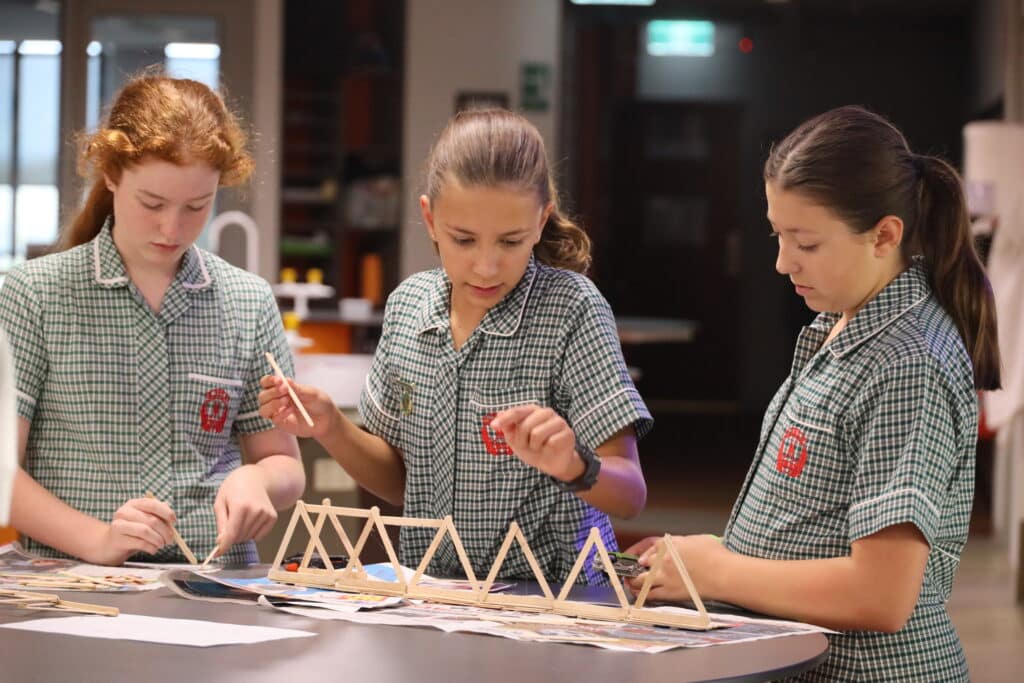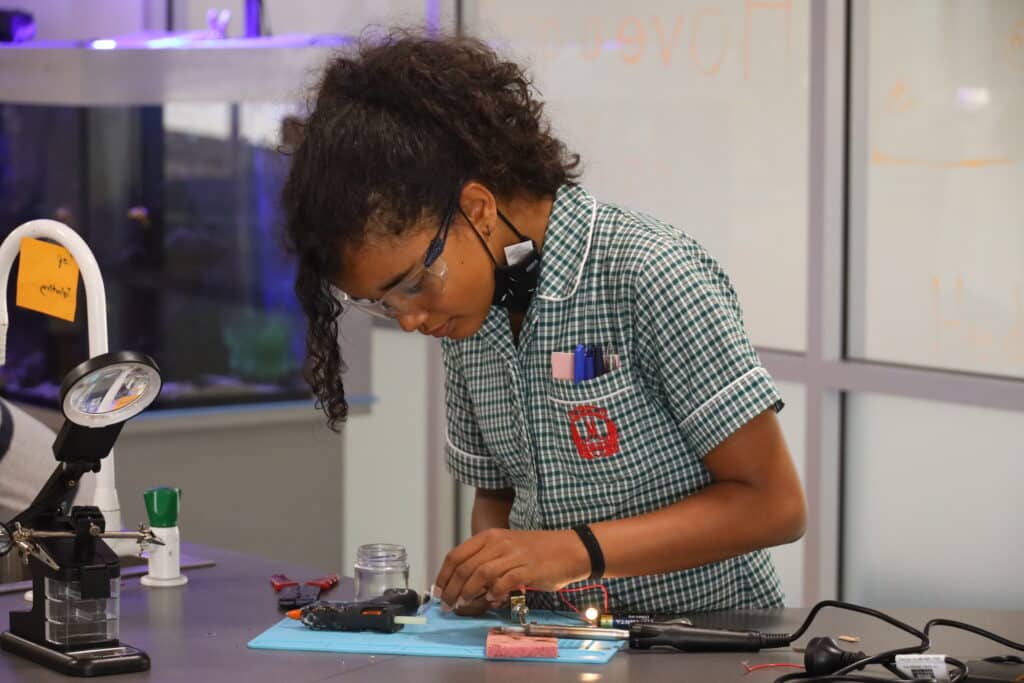The World Needs Girls in STEM – Jennifer Oaten

STEM plays an integral role in every aspect of our daily lives. From the moment we rise in the morning to when we retire at night, we constantly lean on STEM for support. It is present in the electrical system that brings our toaster to life, the heating mechanism for our hot water, and the devices we utilise, such as laptops and mobile phones. Whether it is the innovative technology driving Netflix and ChatGPT, a virtual reality tour of a museum, or the satellites enabling Google Maps, STEM is the backbone of it all. Furthermore, it is essential in medical developments like COVID-19 vaccinations, the food we eat, the payment transactions we make, and even how we travel all rely on STEM.

STEM is everywhere!
In today’s fast-paced, technology-driven world, science, technology, engineering, and mathematics (STEM) skills are more important than ever. These fields have the potential to revolutionise our world, solve pressing global challenges, and change the way we live, work, and communicate. However, despite the growing demand for STEM professionals, there remains a significant gender gap in these fields, with women still largely underrepresented.
To address this imbalance and ensure that girls have equal opportunities to excel in STEM careers, it is vital to foster their interest and passion for these subjects from an early age. In this blog post, we will explore the importance of STEM education for girls, the barriers they face, and how schools, parents, and communities can help support and encourage their pursuit of STEM fields.

Why STEM Education Matters for Girls
STEM education is crucial for girls for several reasons:
Economic Opportunity: STEM careers typically offer higher salaries and better job security than non-STEM professions. There are many jobs available in STEM, and it is one of the fastest growing areas of employment. While there is no standard definition of a STEM worker, up to 74 occupations are included as being STEM-related. By encouraging girls to pursue STEM subjects, we empower them to achieve financial independence in an area with job security and future opportunities.
Innovation and Problem-Solving: Women bring unique perspectives and approaches to problem-solving, which can lead to breakthrough innovations and solutions. By having more women in STEM fields, we can tap into their creativity and expertise to tackle some of the world’s most pressing issues, such as climate change, disease control, and sustainable development. Women also need to participate in STEM to make sure the experiences and needs of women are included in studies and in the design of products and services.
Gender Equality: By breaking down gender stereotypes and promoting the participation of girls in STEM fields, we can challenge societal norms and create a more just and equitable world for all. According to the Australian Academy of Science, in Australia, only 16% of the STEM skilled workforce are women, while 90% of women with a STEM qualification work in non-STEM related fields. More women in STEM roles help form a stronger foundation for future choices and will help establish career pathways for girls.
- Personal Development: STEM education fosters critical thinking, problem-solving, and collaboration skills, which are essential for success in any career. By engaging girls in STEM activities, we help students build the foundation for a fulfilling and successful future either in or beyond STEM.

Barriers to Girls' Success in STEM
Despite the clear benefits of STEM education for girls, they continue to face barriers that can hinder their progress. Some of these challenges include:
Stereotypes and Bias: Gender stereotypes often portray STEM fields as ‘male-dominated’ or ‘too difficult’ for girls. These stereotypes can negatively impact girls’ self-esteem and discourage them from pursuing STEM subjects. For some girls taking on a STEM career dominated by males is daunting.
Lack of confidence: Girls often doubt their ability to succeed and prefer to avoid being involved if they are not going to be successful. An example of this is coding which is an endless process of trial and error that requires perseverance – and imperfection. Some girls will be afraid to ask questions when tasks are challenging and use avoidance rather than make mistakes.
Lack of Interest: Girls often have a strong interest in STEM during their upper primary years; however, this enthusiasm tends to diminish as they progress through high school. Consequently, fewer girls are inclined to pursue STEM degrees and ultimately work in STEM-related fields. Misconceptions about what STEM careers look like in the real world and a limited understanding of the diversity of career pathways and opportunities may also limit girls making these choices.
Lack of Role Models: The underrepresentation of women in STEM fields means that girls have fewer female role models to look up to and emulate. This can make it difficult for them to envision themselves as successful scientists, engineers, mathematicians, or on many other STEM pathways.
- Social Pressure: Girls may encounter peer pressure to steer clear of STEM subjects when they are perceived as challenging, opting instead for subjects considered popular and enjoyable. This may limit girls’ willingness to try and be individuals and make pursuing their interests and passions challenging.

Strategies to Support Girls in STEM
To address these barriers and ensure that girls have equal opportunities to succeed in STEM fields, schools, parents, and communities must work together to create supportive and inclusive environments. Here are some strategies to consider:
Develop Confidence: Provide opportunities to create, design and build cool things and ensure girls are aware that STEM is not just about coding. Teach girls to sit with the discomfort of not knowing the correct answer immediately, show grit and perseverance, and accept that great learning comes from trial and error and making mistakes. Our new woodworking elective provides these opportunities. It is also important to encourage girls to keep trying if they lack confidence or doubt themselves – and tell them you believe in them.
Create Engaging Learning Experiences: Develop curriculum and teaching methods that are hands-on, collaborative, and connected to real-world people problems. Our Connecting Learning to Life framework and innovative emPOWER program make STEM subjects more accessible and appealing to girls, inspiring them to pursue careers in these fields and developing the necessary skills and confidence.
Challenge Stereotypes and Bias: Create a school culture that values diversity and promotes gender equity in all aspects of education. Showcasing and promoting the variety of STEM opportunities and valuing these as a community is just as important as supporting the passions and interests of individuals through opportunities and competitions. Our suite of electives, such as STENgineers, Science Quest, BrainSTEM, and Robotics & Coding, all provide stimulating STEM experiences.
Promote Positive Role Models: Highlight the achievements of women in STEM and share their stories with girls. Encourage girls to seek out mentors and role models who can provide guidance, support, and inspiration. Santa Maria does this through our Sisterhood Lunch Series, where Alumni share their journeys post-school. Young, vibrant female teachers who are passionate about inspiring girls to continue their fascination with STEM can also be very influential in encouraging girls to choose these electives.
Provide Extracurricular Opportunities: Offer clubs, workshops, and competitions that focus on STEM subjects and allow girls to explore their interests and passions outside the classroom, like Santa Maria College’s Ladies in Lab Coats, Maths Club and Robotics programs. This enables girls to connect with others with similar interests and to develop their potential through fun, challenging activities.
- Encourage Parental Involvement: Engage parents in their daughters’ STEM education and encourage them to support their interests and aspirations. Provide resources and guidance to help parents foster a love of STEM at home, sharing conversations about STEM and promoting opportunities in this field.

By prioritising STEM education for girls, we can empower them to become the innovators, leaders, and problem-solvers of tomorrow. As they break barriers and shatter stereotypes, these young women will play a crucial role in shaping the future of our world.
By providing them with the support, resources, and opportunities they need to excel in STEM fields, we can create a more diverse, equitable, and inclusive society where all individuals participate in solving our global challenges.
By fostering their interest and passion for science, technology, engineering, and mathematics, we can help them build a brighter future for themselves and for our world.

Michelle Attains Lead Teacher Status
Our Head of Professional Learning, Michelle Carrick, recently attained national certification as a Lead Teacher, one of only 64 people nationally to have attained this certification in 2023.

From the President: May 2024
We have some great stories in this month’s blog. Also Look out for information about our OGA Movie Night screening of The Way, My Way.

Lisa Sorger: Sisterhood Network Series
Join us for an inspiring evening at the second session of our Sisterhood Networking Series with Dr Lisa Sorger (Ramakrishnan, 1987).
- Featured
Author: Santa Maria College
Santa Maria College is a vibrant girls school with a growing local presence and reputation. Our Mission is to educate young Mercy women who act with courage and compassion to enrich our world. Santa Maria College is located in Attadale in Western Australia, 16 km from the Perth CBD. We offer a Catholic education for girls in Years 5 – 12 and have 1300 students, including 152 boarders.







